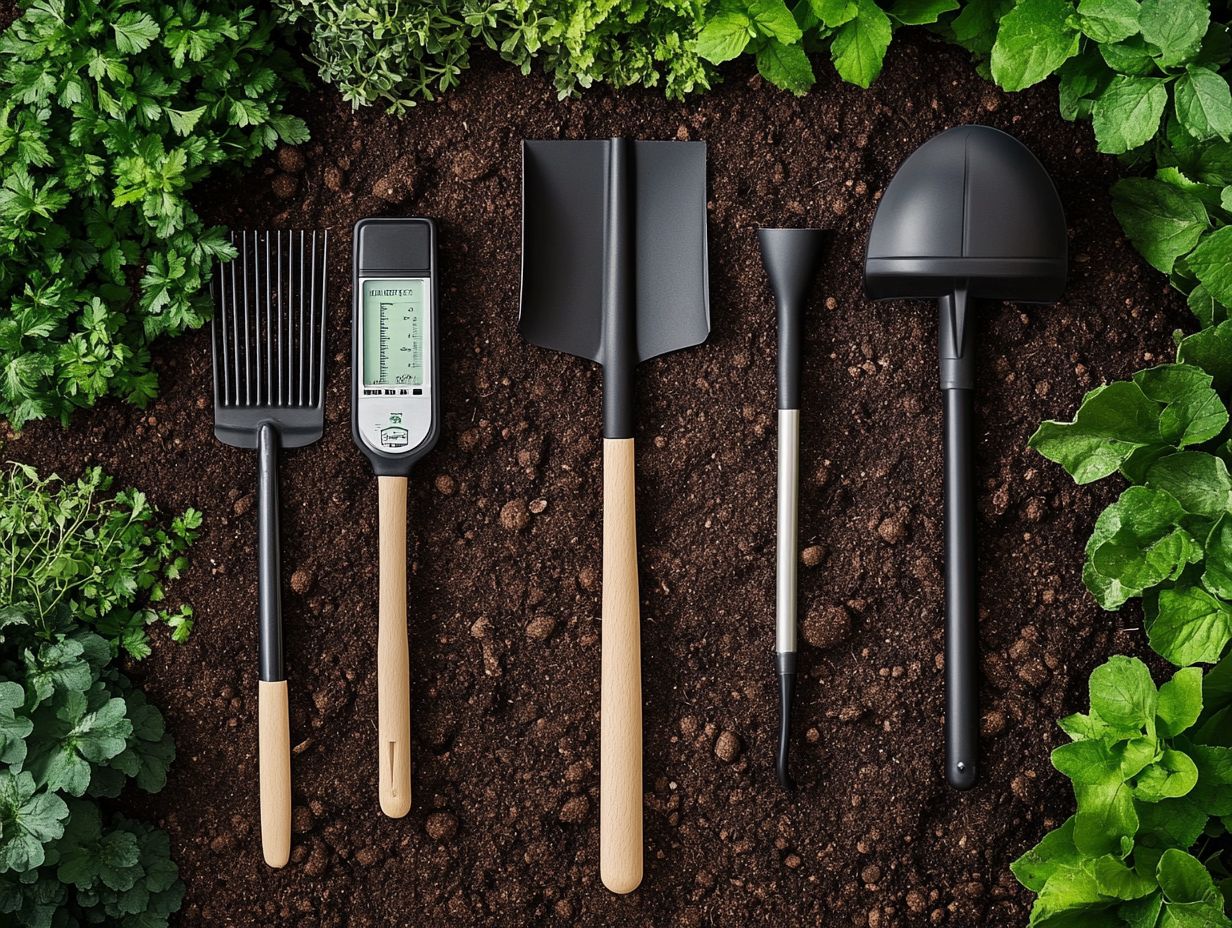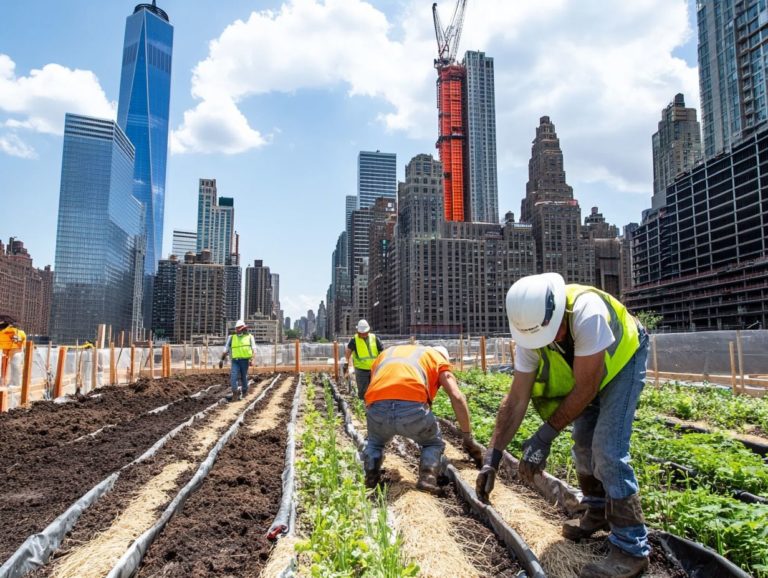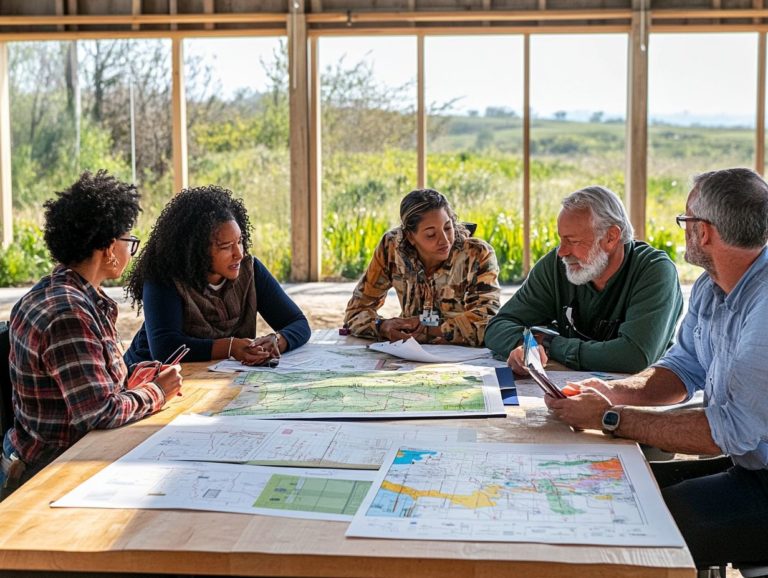5 Essential Tools for Soil Conservation
Soil conservation plays a crucial role in ensuring sustainable agriculture, maintaining environmental health, and protecting our natural resources.
Consider these five indispensable tools that can help you preserve soil quality and combat erosion:
- Soil moisture sensors
- Cover crops
- No-till farming
- Windbreaks
- Contour farming and terracing
Each of these practices enhances soil health and provides distinct benefits that can seamlessly integrate into your farming or gardening routines, promoting biodiversity maintenance.
Delve into the long-term advantages that come with embracing these innovative techniques, including effective erosion control and sustainable practices.
Contents
- Key Takeaways:
- 1. Soil Moisture Sensors
- 2. Cover Crops
- 3. No-Till Farming
- 4. Windbreaks
- 5. Terracing
- How Can These Tools Help with Soil Conservation?
- What Are the Benefits of Using Soil Moisture Sensors?
- How Do Cover Crops Help with Soil Conservation and Biodiversity Maintenance?
- What Is No-Till Farming and How Does It Conserve Soil?
- How Do Windbreaks Protect Soil from Erosion?
- What Is Terracing and How Does It Help with Soil Conservation?
- What Other Tools Can Be Used for Soil Conservation?
- How Can Farmers and Gardeners Incorporate These Tools into Their Practices?
- What Are the Long-Term Effects of Implementing These Tools for Soil Conservation?
- Frequently Asked Questions
- What are the five essential tools for soil conservation?
- Why are cover crops important for soil conservation?
- How does conservation tillage benefit soil conservation?
- What is contour farming and how does it help with soil conservation?
- What are terraces and how do they promote soil conservation?
- How do windbreaks contribute to soil conservation?
Key Takeaways:
- Soil moisture sensors help monitor and optimize irrigation, preventing over-watering and soil erosion.
- Cover crops improve soil health and reduce erosion by providing essential nutrients and creating a protective cover.
- No-till farming conserves soil by reducing disturbance and promoting regeneration.

1. Soil Moisture Sensors
Imagine having the power to monitor your soil moisture in real-time! Soil moisture sensors are transformative tools at your disposal, offering real-time insights into soil moisture levels.
This technology gives you the power to optimize irrigation practices and elevate your overall agricultural monitoring, both of which are crucial for effective land management and soil conservation.
By harnessing these sensors, you can make informed decisions that not only combat soil degradation but also promote sustainable practices, such as crop rotation, boosting crop yields while preserving ecological balance.
These sensors use advanced methods to measure moisture accurately, ensuring water is applied only when truly necessary. This level of precision conserves precious water resources and substantially minimizes erosion risks, as overwatering can cause runoff and deplete topsoil.
By dynamically monitoring soil health, you can fine-tune your cultivation strategies to support a thriving ecosystem and enhance biodiversity, ultimately fostering resilient agricultural landscapes that withstand climate challenges.
2. Cover Crops
Cover crops can be a game-changer for your farm! They are essential for promoting biodiversity and enhancing soil health, acting as a protective barrier that reduces erosion and improves nutrient cycling within your agricultural ecosystem.
When you integrate these crops into your traditional farming practices, you’re not just preventing soil degradation; you’re also enriching the organic matter, embracing a more sustainable approach to land management.
You might consider incorporating various types of cover crops, such as legumes, grasses, and brassicas, each bringing unique advantages. For example, legumes fix nitrogen in the soil, boosting its fertility, while deep-rooted grasses help break up compacted layers, enhancing soil structure. Brassicas excel at naturally suppressing weeds and managing pests, making them a valuable ally in your farming efforts.
By cultivating a diverse plant community, these cover crops not only bolster soil conservation but also create a habitat that encourages beneficial microorganisms and insects, further promoting ecological balance and enhancing biodiversity maintenance within your farming system.
3. No-Till Farming
No-till farming stands out as an effective approach that minimizes soil disturbance, leading to improved soil structure, enhanced organic matter retention, and a significant reduction in the risk of soil degradation. This sustainable practice promotes moisture retention and nutrient cycling. It also plays a crucial role in erosion control and overall soil conservation, making it a top choice for environmentally conscious farmers.
By adopting no-till practices, you can cultivate a thriving ecosystem within the soil that supports a variety of plants and animals and enhances resilience against weather extremes. These essential organisms work tirelessly, breaking down organic materials and enriching the soil in the process.
No-till farming aligns seamlessly with broader sustainable land management strategies. It reduces the carbon footprint of farming operations, encourages biodiversity, and supports the long-term productivity of the land. This way, you not only secure immediate benefits but also contribute to the health of the environment for future generations.
4. Windbreaks
Windbreaks are rows of trees or shrubs positioned to control soil erosion, safeguard crops, and enhance habitat quality for various species. Acting as natural barriers against wind, these structures uphold the ecological integrity of agricultural landscapes, fostering healthier soils and promoting improved variety of plants and animals.
These barriers can take many forms, from single rows to multiple layers of vegetation, and they can be tailored with a mix of native species selected for their adaptability to local conditions. Implementing windbreaks reduces wind velocity and helps retain moisture while decreasing reliance on chemical fertilizers by nurturing a rich, organic soil environment.
As a farmer, you can strategically position these systems around your fields to create sheltered microclimates. This approach supports beneficial insects and wildlife, enhancing their essential roles in pollination and pest control.
5. Terracing

Terracing is an ancient agricultural practice that transforms sloped terrain into stepped levels. This technique effectively mitigates soil erosion and enhances sediment control. It reduces land degradation and fosters sustainable farming practices essential for combating the adverse effects of climate change on agriculture.
Diverse cultures have embraced terracing throughout history, tailoring it to their unique environments from the lush rice paddies of Asia to the resilient agricultural systems of the Andes in South America. By interrupting the flow of water and slowing its descent, these terraces play a crucial role in retaining moisture and soil nutrients, ultimately boosting farmland productivity. This sustainable method preserves the soil s integrity while promoting biodiversity through varied micro-environments.
Modern agriculturalists increasingly recognize terracing’s significance for its enduring effectiveness against environmental challenges and its role in promoting biodiversity.
How Can These Tools Help with Soil Conservation?
The integration of innovative tools like soil moisture sensors, cover crops, no-till farming, windbreaks, and terracing can significantly enhance your soil conservation efforts. Incorporating these 5 techniques for soil erosion control arms you with powerful, sustainable practices essential for preserving ecological integrity. Together, they contribute to erosion control, improved water filtration, and the maintenance of organic matter, ensuring your agricultural land remains productive and resilient against the challenges posed by climate change.
By utilizing the strength of technology and nature s processes, you can foster healthier soil ecosystems fundamental to productive farming. Soil moisture sensors allow for precise irrigation, minimizing water waste while maximizing your crop yields. Cover crops enrich your soil by fixing nitrogen and preventing erosion during off-seasons. Meanwhile, no-till farming reduces soil disturbance, enhancing its structure and promoting biodiversity.
Incorporating windbreaks protects your crops from harsh winds, while terracing manages water runoff effectively, supporting sustainable water management. Collectively, these practices not only boost productivity but also create a holistic approach to agriculture that prioritizes environmental stewardship for future generations.
What Are the Benefits of Using Soil Moisture Sensors?
Utilizing soil moisture sensors brings a wealth of benefits your way, including precise agricultural monitoring that allows you to maintain optimal moisture levels. This not only enhances crop health and productivity but also promotes effective erosion control.
These sensors play a crucial role in improving water filtration and fostering sustainable land management practices, paving the way for chemical-free farming alternatives.
By providing you with real-time data, these tools empower you to make informed decisions about irrigation schedules, ultimately reducing water usage and cutting down on waste. With a deeper understanding of soil moisture dynamics, your crops can develop healthier root systems, enabling them to better withstand drought conditions.
This means you could see not just higher yields, but also resilient soils that support biodiversity.
Integrating soil moisture sensors into your agricultural practices helps you mitigate the adverse effects of over-irrigation, embracing a more sustainable approach that benefits both the environment and farming communities, ensuring long-term ecological integrity.
How Do Cover Crops Help with Soil Conservation and Biodiversity Maintenance?
Cover crops are critical for soil conservation as they enhance biodiversity and nutrient cycling. They effectively combat soil degradation while improving overall soil structure. By protecting the soil from erosion and enriching it with organic matter, these crops become a cornerstone of sustainable farming practices.
When you cover the ground with vegetation, you significantly minimize the impact of rainfall, which reduces water runoff and safeguards the precious topsoil. As these crops decompose, they release vital organic materials that boost soil fertility, fostering a thriving environment for beneficial microorganisms. These organisms play a crucial role in breaking down nutrients, making them more accessible for your future crops.
The root systems of cover crops create channels in the soil, improving aeration and increasing water infiltration key factors in maintaining healthy, productive land.
What Is No-Till Farming and How Does It Conserve Soil?
No-till farming is a groundbreaking agricultural method that conserves soil by minimizing disturbance. It fosters better nutrient cycling and significantly reduces erosion challenges. This practice enhances soil structure and health while aligning with sustainable agricultural techniques that combat soil degradation.
By cutting down on plowing, you allow for the natural preservation of the living organisms in the soil and organic matter, cultivating a vibrant ecosystem beneath the surface. This method supports moisture retention, which is essential for crops to thrive during periods of drought.
When you integrate no-till techniques with cover cropping and crop rotation, you promote biodiversity, minimize pest pressures, and bolster resilience against climate variability. Farmers who embrace this strategy often witness their fields becoming more productive over time, highlighting the intricate connection between ecological health and agricultural success.
Consider implementing these transformative practices in your farming for a more sustainable future!
How Do Windbreaks Protect Soil from Erosion?

Windbreaks protect against soil erosion. They are barriers that reduce wind speed, safeguarding your crops and soil.
Beyond their crucial role in soil protection, windbreaks enhance habitat quality and boost the ecological integrity of agricultural systems. By slowing down prevailing winds, windbreaks create microclimates that benefit various plant species and improve moisture retention in the soil.
This fosters healthier crop growth and promotes biodiversity by providing shelter to wildlife.
Integrating windbreaks into your farming landscape optimizes their effectiveness. Positioning them strategically along field edges or across open spaces maximizes their protective benefits. Thoughtful placement and selecting suitable plant species greatly enhance your farm s productivity and ecological resilience.
What Is Terracing and How Does It Help with Soil Conservation?
Terracing is an effective method to protect soil. It transforms sloped terrain into flat areas, reducing erosion and enhancing sediment control.
This approach stabilizes the landscape and promotes sustainable agricultural practices by improving water retention and nutrient cycling, vital for healthier soils.
Various cultures have embraced terracing throughout history, from the ancient Inca in the Andes to rice farmers in Southeast Asia. This adaptability proves its effectiveness across different climates and soil types.
By breaking up the slope into manageable sections, terraces facilitate efficient irrigation and rainfall absorption.
In today s agricultural landscape, implementing terracing helps tackle challenges posed by climate change. It enables farmers to combat soil degradation while maximizing crop yields. This revival of an ancient technique holds great promise for future farming!
What Other Tools Can Be Used for Soil Conservation?
Numerous practices and technologies can enhance your soil conservation efforts. Integrated pest management, contour farming, and using cover crops all improve habitat quality.
These sustainable practices work together to control erosion, maintain soil health, and cultivate a resilient agricultural ecosystem.
Embracing agroforestry practices boosts biodiversity. Trees reduce wind speed and provide shade, which helps retain soil moisture.
Using mulch is another effective strategy. It suppresses weed growth and enriches soil structure and fertility as it breaks down.
Employing conservation tillage minimizes soil disturbance, dramatically reduces erosion, and preserves organic matter.
These practices harmonize beautifully with cover crops, crafting a comprehensive approach that lays a sustainable foundation for agricultural productivity while safeguarding vital soil resources.
How Can Farmers and Gardeners Incorporate These Tools into Their Practices?
Farmers and gardeners can integrate soil conservation tools into their practices. Embracing a complete method to land management prioritizes sustainability and proactive erosion control.
Start by learning about your land’s specific needs. Attend workshops and engage with local agricultural specialists for valuable insights.
Careful planning is crucial. Before making any changes, conduct a thorough assessment of your soil health and pinpoint areas in need of enhancement.
Beginning with one or two techniques at a time allows for easier management and clearer observation of results. Gradually scaling up these practices boosts your productivity and ensures sustainable advantages for future generations.
Ultimately, your commitment to continuous learning and adaptation will serve as the cornerstone for thriving in modern agriculture.
What Are the Long-Term Effects of Implementing These Tools for Soil Conservation?
Implementing soil conservation tools has significant long-term benefits for both soil health and agricultural sustainability. These practices foster improved biodiversity and a stronger ecological balance within your farming systems.
These tools include cover cropping, crop rotation, and reduced tillage. They encourage the development of healthy soil structures while promoting moisture and holding nutrients.
As a result, you ll likely see increased crop yields, which bolster your livelihood and contribute to food security within your community.
Healthy soils are champions in carbon sequestration, capturing carbon dioxide from the atmosphere. By embracing these sustainable practices, you cultivate an overall method to farming that nurtures a vibrant ecosystem, supporting diverse forms of life and ensuring your agricultural endeavors thrive in harmony with the environment.
Frequently Asked Questions

Curious about soil conservation tools? Here are the essentials!
What are the five essential tools for soil conservation?
The five essential tools for soil conservation are cover crops, conservation tillage, contour farming, terracing, and mistakes to avoid in soil conservation like using ineffective practices.
Why are cover crops important for soil conservation?
Cover crops help protect soil from erosion. They improve soil health and increase organic matter and nutrient levels.
How does conservation tillage benefit soil conservation?
Conservation tillage reduces soil disturbance. It helps retain moisture and increases soil organic matter.
What is contour farming and how does it help with soil conservation?
Contour farming involves planting crops parallel to the natural contours of the land. This method helps prevent soil erosion by slowing down water runoff.
What are terraces and how do they promote soil conservation?
Terraces are level areas built into a sloping field to prevent soil erosion. They help slow down water runoff and allow for more efficient use of water for plants.
How do windbreaks contribute to soil conservation?
Windbreaks are rows of trees or shrubs planted along the edges of fields. They slow down wind and reduce soil erosion while providing habitat for wildlife and improving air quality.






